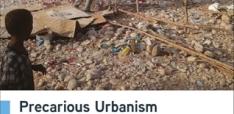'The Donors’ Dilemma' - The Future of Aid: 2030 ODA No More
This Column by Nancy Birdsall is part of Global Policy’s e-book, ‘The Donors’ Dilemma: Emergence, Convergence and the Future of Aid', edited by Andy Sumner. Contributions from academics and practitioners will be serialised on Global Policy until the e-book’s release in the first quarter of 2014. Find out more here or join the debate on Twitter #GPfutureofaid.
I see a world in 2030 in which there is no longer a global poverty line (certainly not a line at $1.25 in real PPP 2005 dollars); and in which ODA or official government-sponsored aid as we know it today will have almost completely disappeared.
The global goal of eliminating “extreme poverty” will have been supplanted by country-specific goals – to reduce poverty below country-specific poverty lines and to increase median wages and incomes. Across countries, the media and the international community will use median income (or consumption) as an indicator of typical well-being and of a country’s general state of development progress.
What we know today as ODA will have been largely replaced by two non-aid sources of financing from high-income to developing countries: non-concessional loans from development banks (multilateral and national) for development investments focused on growth and job creation; and transfers from high-income to developing countries in support of such global public goods as reducing deforestation and managing non-state terrorism and crime.
These two changes assume a world in which market-led growth will have reduced absolute poverty in the developing world to close to zero but the broader goals of development—and prosperous and secure societies everywhere—face greatly increased risks due to climate change, non-state terrorism, such global bads as new pandemics and collapse into conflict in parts of the world, and the tensions created by stark inequalities in ever-more interconnected global markets.
The end of “ending” extreme, absolute poverty; the median will become the message
Why the end of the more or less official Millennium Development Goal of eliminating extreme poverty line (of $1.25 a day), a global goal included by President Obama in his 2013 State of the Union address, and recently announced by Jim Yong Kim, the president of the World Bank, as that institution’s bottom-line objective?
The answer is simple. The poor will always be with us, because poverty is a relative concept; as global extreme poverty declines to near zero in the world, nationally defined poverty lines will matter more. Developing countries will be setting the agenda for development, and even today’s low-income countries will have little reason to go along with global goals set in high-income countries to motivate official “aid” -- that in any event will no longer be available to them in substantial amounts.
In Latin America, country poverty lines range from $3 to $8 a day, and the income “line” that divides not only those currently poor but those highly vulnerable to falling into poverty is at about $10 (household income per capita per day). And it is at about $10 per person per day people start to self-declare as “middle class”, as explained in this World Bank report. Below $10 many people are not “poor” by the conventional absolute standard, but their income and material well-being are at constant risk: of loss of employment, a road injury, a health problem, loss of a small business to robbery or a natural disaster, or of course, a prolonged recession following a financial panic. People in households that are just a few weeks of lost income away from becoming poor feel vulnerable and anxious; their constant concern is their scarcity (as in Sendhil Mullainathan’s fine new book) of, yes, money, to meet the most basic needs of food, shelter, clothing, health care and schooling.
The “line” that divides the vulnerable and anxious from the secure, consolidated middle class, will be different in different countries, even in PPP terms, simply because it is a line defined in part relative to average income. In India it might be $7 or $8. The official poverty line in the US today is $15-$20 (depending on household size) a day; in the European Union countries it is closer to $30 a day (where it is defined as 0.6 of median income, explicitly recognizing that poverty is relative).
Why then the median? With the decline in absolute and extreme poverty in the developing world, median consumption will rise (across the developing world as a whole from about $3 to $5). But the billions of people living at and below the median, though not poor in the absolute sense, with daily consumption below $10, will be far from materially secure (see table, based on sensible growth rates and no changes in countries’ current income distributions as explained in this paper).

Source: Birdsall, Lustig, and Meyer (2013), based on Foure, Bénassy-Quéré, and Fontagne (2012), Milanovic (2010), and United Nations Population Division (2012).
Note: Median daily income/consumption and GDP per capita measured in constant 2005 PPP dollars. Projections were generated using data from Milanovic (2010) using ventiles of country income and consumption distributions. Thus, we use ‘>95’ to designate cases in which fewer than five percent of the population lives above $10 per day.
They will have rising expectations – for justice and good government as well as for upward mobility -- but live in a constant state of anxiety and frustration about their precarious hold on the income they have (as their counterparts today may be already – perhaps comprising many of those who joined the recent protests in Brazil and Chile, and the large numbers who joined the students and liberal secularists in Egypt during the Arab Spring).
In most developing countries, growth and development based on a sound social contract will depend on social and political attitudes and the sense of economic well-being and opportunity of the group around the median – as consumers, workers, taxpayers and political actors -- as much as on the secure middle class. It will require that people in this group – in which primary schooling and self-employment in small enterprises may still be the norm – are productively employed, have access to financial services, and are benefiting from investments in health, education, transportation and other public services. Private investment will require levels of political stability and social cohesion that will depend on the responsiveness of governments to this group.
That reality will make median income and changes in it economically and politically salient within countries, as well as a convenient indicator across countries and over time. That will be the case especially where inequality is high and growing (consider the oft-cited stagnation of the median wage in the United States in the last several decades), and where populations resent a rich elite seen to be benefiting from insider political access and economic privileges.
Why the end of ODA as we know it today?
The same changes that will make the median rather than the poverty rate the standard measure of material well-being and development progress will put ODA out of business.
Instead of today’s ODA there will be two other major sources of official outside funding for developing countries. First (1) will be lending by multilateral (e.g. the World Bank, the regional development banks) and national (e.g. the US OPIC, the British Commonwealth Development Corporation) development finance institutions from their hard windows at below market prices -- not concessional but cheaper, available in bad years and thus counter-cyclical, and with longer terms at lower rates than in the market. In the case of the multilaterals, lending will be underwritten by some capital of middle-income as well as high-income countries, including through their own institutions as with the Andean Development Corporation today and the proposed BRICS bank. Second (2) will be transfers from high-income countries to developing countries in support of global public goods, e.g. to protect forests, to subsidize clean energy and compensate for fossil fuels not exploited, to underwrite pandemic surveillance, and for spending to undercut cross-border non-state terrorism, piracy, drug and sex trafficking, etc. Transfers in support of global public goods will not necessarily go more to poorer than to middle-income countries, as tends to be the case today; they will go where they can be most effectively deployed at the lowest cost.
(Private charitable transfers and remittances largely from richer to poorer countries will continue, perhaps at even a higher rate relative to global GDP than today, assuming the current trend of increasing interdependence and reduced distances, psychological as well as economic, continues.)
Why loans not aid?
The shift from grant aid to development bank borrowing for most of today’s developing countries will occur in part because of expected growth in most countries’ per capita income in the next 25 years. The number of countries eligible for borrowing from the soft window, IDA, of the World Bank could decline from 68 to 31 by 2025 using the current income cutoff according to this excellent report of the Center for Global Development. Many low-income countries that are major recipients of foreign aid today (Ghana, Mozambique, Tanzania, Mongolia) will have substantial income from oil, gas and other natural resources and will no longer rely on grant aid and concessional loans. Instead they will be borrowing from the hard windows of the development banks, as well as on the private market (as some are already today against future income).
Already, as Andy Sumner has documented, the majority of the world’s “poor” living below $2 a day live in middle-income countries (using the current World Bank classification of countries with per capita income above about $1,000 a year). That will be even more the case by 2030.
The middle-income countries with per capita income near and above $5,000 will be able and willing to provide capital to multilateral banks themselves. They will do so to reduce their cost of borrowing for their huge infrastructure needs, and in order to have greater influence and less intrusive conditions and red tape associated with that borrowing. They will borrow not only from the World Bank and the major regional development banks but from single country development finance institutions (China and Brazil have DFIs or DFI-equivalents and will no doubt be lenders as well as borrowers) at cheaper rates than they could on the private market, to invest in local public goods especially infrastructure and education systems.
The World Bank and the large regional development banks are already not the only development lenders. The Andean Development Corporation is capitalized and managed by 16 countries in Latin America (plus Spain and Portugal, who are not borrowers) to which it lends; its rates of paid-in capital and its cost of borrowing are higher than that of the multilateral banks but lower than any single member’s cost of borrowing on the market. The proposed BRICS Bank would be a new borrow-owned and managed development bank. The European Investment Bank lends not only to Ireland, Poland and Hungary but to Germany and its other high-income members. The Brazilian development bank currently has a larger portfolio in Brazil than the Inter-American Development Bank and the World Bank in Latin America. The Chinese use the equivalent of a development bank to lend to state enterprises at home and to finance cheap loans to governments in Africa. And of course most of the high-income countries have development finance institutions (OPIC in the United States, the Commonwealth Development Corporation in the United Kingdom) that, like the private sector windows of the multilateral banks, encourage private investment in developing countries through use of low-cost debt, equity and insurance.
In 2030 there may well still be weak and failing and conflict-ridden states (though not necessarily those you would predict today) that cannot borrow for development investments. Their populations (but not their governments) will be receiving recurring rounds of humanitarian aid and infusions of “emergency” food and disaster relief, as well as private transfers from their diasporas and global private charities. That is not so different from today; to the extent humanitarian and emergency relief are defined by rich countries as 'aid', they may be counted as ODA. But those transfers will not constitute development aid in the traditional sense.
Why global public good funding not aid?
The other shift will be from development aid to transfers and subsidies intended to help finance global public good programs in developing countries. Why? First, among the richer countries, there will be increasing attention to the costs of climate change to their own growth and prosperity. Whether through a carbon price, offsets in a cap and trade system, or regulatory rules and standards agreed at the global level, these countries will be committed to reducing global emissions, and seeking low-cost ways to do so. Possibilities will include paying developing countries to preserve their tropical forests and peat swamps, subsidizing the demobilization of installed coal power plants, compensating governments for the higher costs of investing in clean power, and perhaps providing direct cash transfers to low-income populations in developing countries to help compensate for rising energy costs associated with renewables.
Second, richer countries will still be concerned with the problem of non-state actors engaging in terrorism and simple criminality, and with the inability of the poorest countries to manage on their own drug-financed corruption, control of infectious diseases, warning systems for hurricanes and tsunamis and other cross-border ills and risks to the well-being of their richer neighbors. Countries like Haiti, Honduras and Somalia (or their counterparts in 2030) will be the recipients of transfers from richer neighbors (the United States, Mexico, Costa Rica; the Gulf states and Kenya in the case of Somalia), often managed directly by the richer neighbors, to deal with these problems.
The high-income countries will also continue to support basic agricultural and health research in their own countries with global benefits, as well as UN peacekeeping, data, policy and surveillance work of the IMF, the WHO, the FAO and the many other global institutions and clubs as well – presumably at levels that reflect their greater ability to provide that funding. They may from time to time recapitalize the development banks in which they are members in line with their voting shares. There will in that sense still be financing by high-income countries of goods and services with benefits for lower-income countries. But none of this will constitute ODA by today’s definition.
Spending in one’s own interest to address neighbors’ problems is also nothing new. In the 1990s, transfers from the richer members of the European Union to Ireland were on the order of Euro 1 billion per year; between 2007 and 2013 the EU provided 'cohesion' funds of Euro 67 billion to Poland. These are not transfers from very rich countries to very poor ones. The ratio of France’s PPP GDP per capita to that of Poland is 1.7; the corresponding ratio for France and Côte d’Ivoire is 18.7. Any country with a per capita GNP less than 90 percent of the EU average is eligible for cohesion funds. In the last seven years, the EU has devoted almost Euro 347 billion – more than 35 percent of its total budget during that period – to its regional and cohesion programs, including for public transport between member countries, to finance pollution control in coal-intensive eastern member states, to support cross-border public health initiatives, and for social inclusion schemes to improve public services for vulnerable groups. In the same period, the United States has committed millions of dollars to the control of drug trafficking in Mexico and other countries of Central America, and millions more for Plan Colombia to reduce trafficking and combat insurgent groups dependent on drug money in that country.
In other words
There will still be a growth and development 'business' in 2030, because with median consumption at only about $5 in the developing world, most people will still live below the line that divides the materially secure middle class from the insecure and anxious. It will be focused on growth and economic opportunity to move billions of people above that line and into the secure middle class. But it will not be about aid; it will be about investment and knowledge transfers financed by borrowing.
There will also be transfers from higher to lower-income countries to finance global public goods. Much of the money that is today called ODA may end up channeled to global goods transfers.
Too many people in 2030 may still live in countries that are ungovernable or badly governed, in refugee camps, and in so-called temporary shelters following natural disasters. They will be beneficiaries of officially financed humanitarian and emergency relief and of private charitable and philanthropic transfers.
Life will be immensely better for most people – but far from good enough.
Nancy Birdsall is the Center for Global Development's founding president. From 1993 to 1998, she was executive vice president of the Inter-American Development Bank. She is the author, co-author, or editor of more than a dozen books and many scholarly papers. Her most recent publications include Cash on Delivery: A New Approach to Foreign Aid and New Ideas on Development after the Financial Crisis, co-edited with Francis Fukuyama.


